Python - matplotlib 数据可视化
在许多实际问题中,经常要对给出的数据进行可视化,便于观察。
今天专门针对Python中的数据可视化模块--matplotlib这块内容系统的整理,方便查找使用。
本文来自于对《利用python进行数据分析》以及网上一些博客的总结。
1 matplotlib简介
matplotlib是Pythom可视化程序库的泰斗,经过几十年它仍然是Python使用者最常用的画图库。有许多别的程序库都是建立在它的基础上或直接调用它,比如pandas和seaborn就是matplotlib的外包,
它们让你使用更少的代码去使用matplotlib的方法。Gallery页面中有上百幅缩略图,打开之后都有源程序,非常适合学习matplotlib。
2 图和子图的建立
2.1 导入matplotlib
import matplotlib.pyplot as plt
import numpy as np
2.2 建立图和子图方式一
plt.plot( )会在最近的一个图上进行绘制
from numpy.random import randn fig = plt.figure(figsize = (8,4)) #设置图的大小 ax1 = fig.add_subplot(2,2,1) ax2 = fig.add_subplot(2,2,2) ax3 = fig.add_subplot(2,1,2) ax3.plot(randn(50).cumsum(),'k--') # plt.plot(randn(50).cumsum(),'k--')等效 ax1.hist(randn(100),bins = 10, color = 'b', alpha = 0.3) #bins 分成多少间隔 alpha 透明度 ax2.scatter(np.arange(30),np.arange(30) + 3*randn(30)) plt.show()
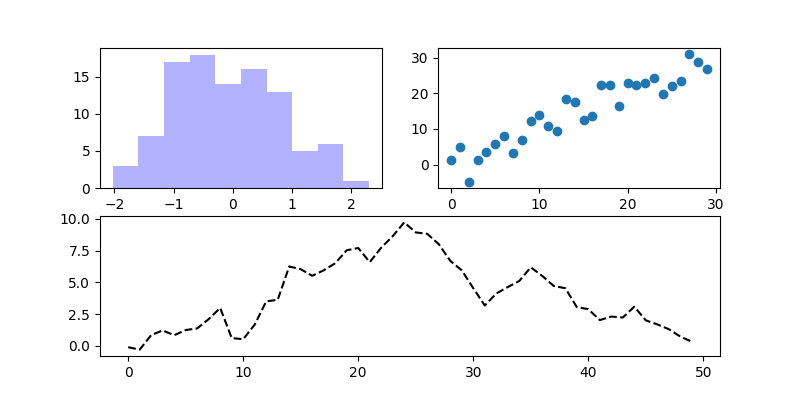
2.3 建立子图方式二
from numpy.random import randn fig, axes = plt.subplots(2,2) #以数组方式访问 t = np.arange(0., 5., 0.2) axes[0,0].plot(t, t, 'r-o', t, t**2, 'bs', t, t**3, 'g^') #同时绘制多条曲线 axes[1,1].plot(randn(40).cumsum(),'b--') plt.show()

2.4 主题设置
使用style.use()函数
df_iris = pd.read_csv('../input/iris.csv')
plt.style.use('ggplot') #'fivethirtyeight','ggplot','dark_background','bmh'
df_iris.hist('sepal length')
plt.show()
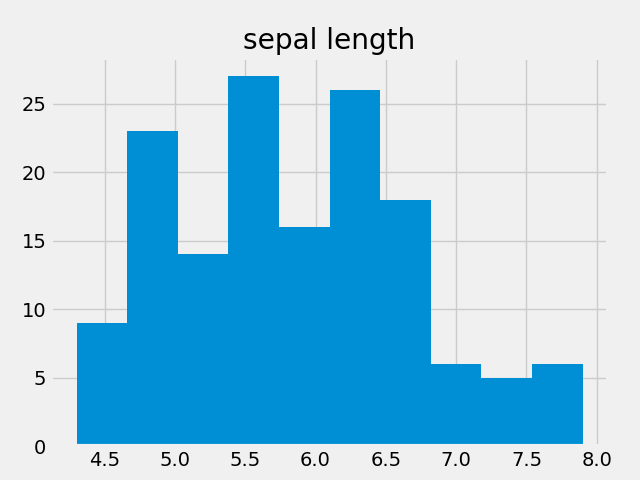
3 颜色、标记、线型、刻度、标签和图例
from numpy.random import randn
fig = plt.figure()
ax1 = fig.add_subplot(1,1,1)
ax1.plot(randn(30).cumsum(),color = 'b',linestyle = '--',marker = 'o',label = '$cumsum$') # 线型 可以直接'k--o'
ax1.set_xlim(10,25)
ax1.set_title('My first plot')
ax1.set_xlabel('Stages')
plt.legend(loc = 'best') #把图放在不碍事的地方 xticks([])设置刻度
plt.show()

等价于下面的代码:
from numpy.random import randn
fig = plt.figure()
ax1 = fig.add_subplot(1,1,1)
ax1.plot(randn(30).cumsum(),color = 'b',linestyle = '--',marker = 'o',label = '$cumsum$') #图标可以使用latex内嵌公式
plt.xlim(10,25) #plt.axis([10,25,0,10])对x,y轴范围同时进行设置
plt.title('My first plot')
plt.xlabel('Stages')
plt.legend(loc = 'best')
plt.show()
4 pandas中的绘图函数
在pandas中,我们具有行标签,列标签以及分组信息。这也就是说,要制作一张完整的图表,原本需要一大堆的matplotlib代码,现在只需一两条简洁的语句就可以了。
pandas有很多能够利用DataFrame对象数据组织特点来创建标准图表的高级绘图方法。
4.1 线型图
from numpy.random import randn fig, axes = plt.subplots(1,2) s = pd.Series(randn(10).cumsum(),index = np.arange(0,100,10)) s.plot(ax = axes[0]) # ax参数选择子图 df = pd.DataFrame(randn(10,3).cumsum(0),columns = ['A','B','C'],index = np.arange(0,100,10)) df.plot(ax = axes[1]) plt.show()
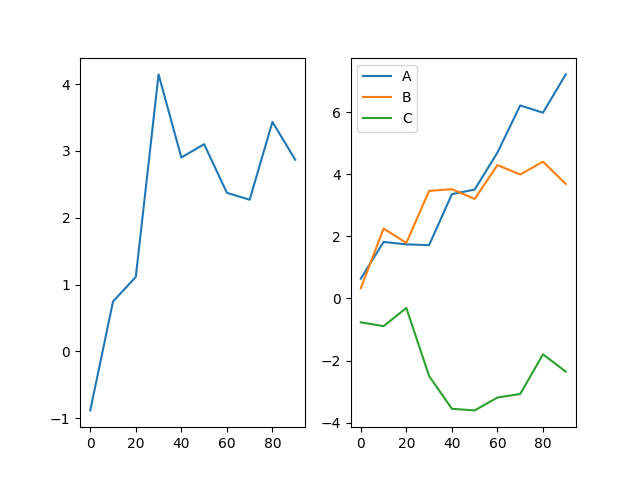
4.2 柱状图
from numpy.random import rand
fig, axes = plt.subplots(1,2)
data = pd.Series(rand(16),index = list('abcdefghijklmnop'))
data.plot(kind = 'bar', ax = axes[0], color = 'b', alpha = 0.7) #kind选择图表类型 'bar' 垂直柱状图
data.plot(kind = 'barh', ax = axes[1], color = 'b', alpha = 0.7) # 'barh' 水平柱状图
plt.show()
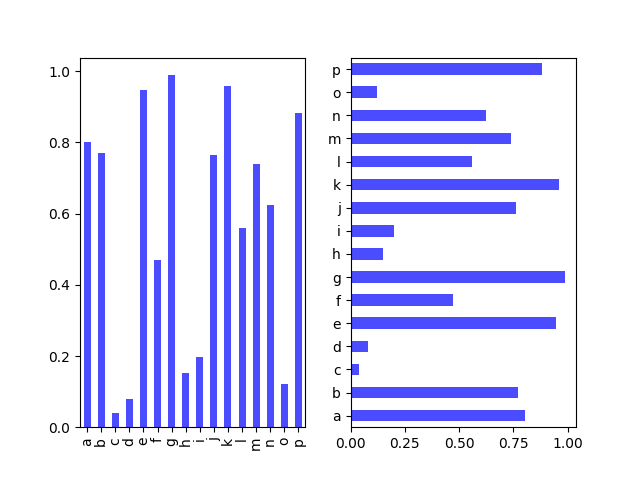
from numpy.random import rand
fig, axes = plt.subplots(1,2)
data = pd.DataFrame(rand(6,4),
index = ['one','two','three','four','five','six'],
columns = pd.Index(['A','B','C','D'], name = 'Genus'))
data.plot(kind = 'bar', ax = axes[0], alpha = 0.5)
data.plot(kind = 'bar', ax = axes[1], stacked = True, alpha = 0.5)
plt.show()
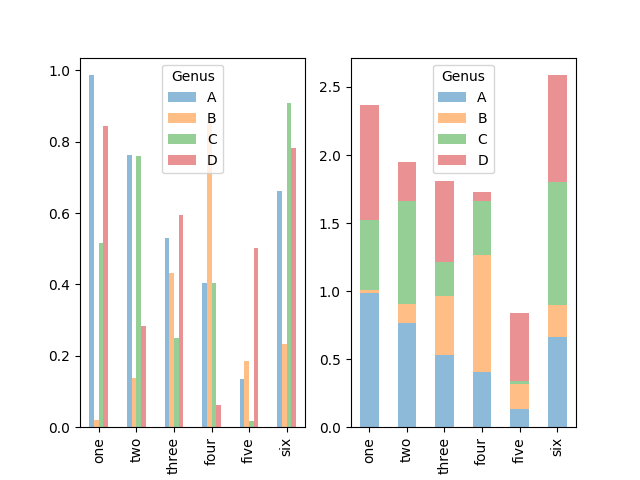
此外,柱状图有一个非常不错的用法,利用value_counts( )图形化显示Series中各值的出现概率,比如s.value_counts( ).plot(kind = 'bar')。
4.3 直方图和密度图
from numpy.random import randn fig, axes = plt.subplots(1,2) data = pd.Series(randn(100)) data.hist(ax = axes[0], bins = 50) #直方图 data.plot(kind = 'kde', ax = axes[1]) #密度图 plt.show()

其实可以一次性制作多个直方图,layout参数的意思是将两个图分成两行一列,如果没有这个参数,默认会将全部的图放在同一行。
df_iris = pd.read_csv('../input/iris.csv')
columns = ['sepal length','sepal width','petal length','petal width']
df_iris.hist(column=columns, layout=(2,2))
plt.show()

4.4 箱型图
箱型图是基于五数概括法(最小值,第一个四分位数,第一个四分位数(中位数),第三个四分位数,最大值)的数据的一个图形汇总,还需要用到四分位数间距IQR = 第三个四分位数 - 第一个四分位数。
df_iris = pd.read_csv('../input/iris.csv') #['sepal length','sepal width','petal length','petal width','class']
sample_size = df_iris[['petal width','class']]
sample_size.boxplot(by='class')
plt.xticks(rotation=90) #将X轴的坐标文字旋转90度,垂直显示
plt.show()
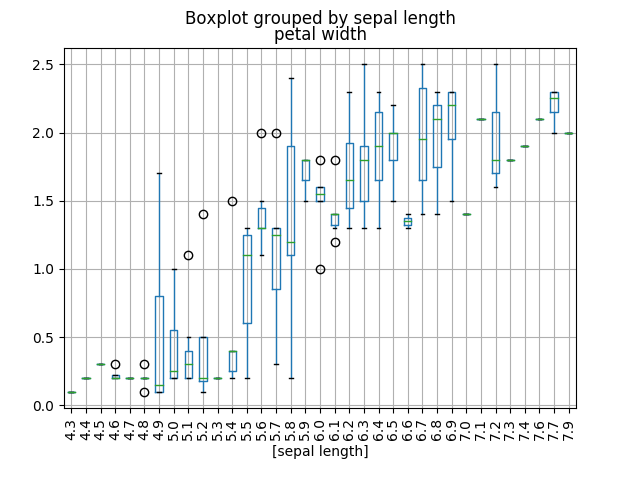
5 参考资料链接
- Gallery页面
- matplotlib — 绘制精美的图表
- Python — matplotlib绘图可视化知识点整理
- Python数据可视化之matplotlib学习笔记
- https://blog.csdn.net/qq_34264472/article/details/53814635 (仅为记录,方便查找使用)



